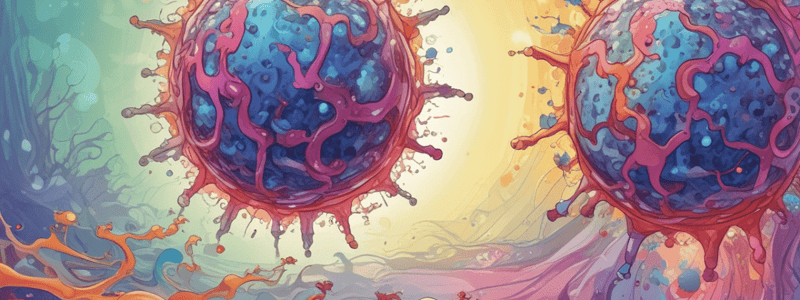Podcast
Questions and Answers
Where do viral DNA and proteins assemble in the life cycle of Cytomegalovirus?
Where do viral DNA and proteins assemble in the life cycle of Cytomegalovirus?
- Endosomal machinery
- Endoplasmic reticulum (ER) and Golgi apparatus
- Nuclear viral factories (correct)
- Cytosol
What is the process by which capsids acquire tegument and viral envelope in the life cycle of Cytomegalovirus?
What is the process by which capsids acquire tegument and viral envelope in the life cycle of Cytomegalovirus?
- Exocytosis
- Trafficking
- Budding (correct)
- Assembly
Where do Cytomegalovirus primarily replicate in the host?
Where do Cytomegalovirus primarily replicate in the host?
- Hepatocytes and vascular endothelial cells
- Macrophages and dendritic cells
- Epithelial cells of gland and mucosal tissue (correct)
- Smooth muscle cells and fibroblasts
What is the result of the host immune response following primary human cytomegalovirus (HCMV) infection?
What is the result of the host immune response following primary human cytomegalovirus (HCMV) infection?
What is the site of latency for Cytomegalovirus in the host?
What is the site of latency for Cytomegalovirus in the host?
How does Cytomegalovirus disseminate in the host?
How does Cytomegalovirus disseminate in the host?
What is the result of reactivation of Cytomegalovirus in the host?
What is the result of reactivation of Cytomegalovirus in the host?
What is the role of the viral assembly complex in the life cycle of Cytomegalovirus?
What is the role of the viral assembly complex in the life cycle of Cytomegalovirus?
What is a characteristic of Cytomegalovirus infection?
What is a characteristic of Cytomegalovirus infection?
What is the primary way HCMV establishes latency in the host?
What is the primary way HCMV establishes latency in the host?
What is the result of the host's immune response during primary infection?
What is the result of the host's immune response during primary infection?
What is the characteristic of CMV-infected cells?
What is the characteristic of CMV-infected cells?
What is the role of CMV-specific CD4+ and CD8+ lymphocytes?
What is the role of CMV-specific CD4+ and CD8+ lymphocytes?
What is the outcome of primary infection in immunocompetent adults?
What is the outcome of primary infection in immunocompetent adults?
What is the risk of CMV infection in immunocompromised individuals?
What is the risk of CMV infection in immunocompromised individuals?
What is the leading cause of congenital neurological disease in pregnant women?
What is the leading cause of congenital neurological disease in pregnant women?
What is a characteristic of HCMV?
What is a characteristic of HCMV?
What is the result of reactivation of latent HCMV infection?
What is the result of reactivation of latent HCMV infection?
What is the subfamily of the herpes virus family to which Cytomegalovirus belongs?
What is the subfamily of the herpes virus family to which Cytomegalovirus belongs?
What is the symmetry of the capsid of Cytomegalovirus?
What is the symmetry of the capsid of Cytomegalovirus?
What is the function of the VP16 enzyme in Cytomegalovirus?
What is the function of the VP16 enzyme in Cytomegalovirus?
What is the function of the gB protein in Cytomegalovirus?
What is the function of the gB protein in Cytomegalovirus?
What is the hallmark of Cytomegalovirus?
What is the hallmark of Cytomegalovirus?
What is the nature of the genome of Cytomegalovirus?
What is the nature of the genome of Cytomegalovirus?
What is the function of the VHS protein in Cytomegalovirus?
What is the function of the VHS protein in Cytomegalovirus?
What is the origin of the lipid part of the envelope of Cytomegalovirus?
What is the origin of the lipid part of the envelope of Cytomegalovirus?
What is the layer located between the capsid and the envelope of Cytomegalovirus?
What is the layer located between the capsid and the envelope of Cytomegalovirus?
What type of CMV antibodies are produced in primary infection and persist for 3 or 4 months?
What type of CMV antibodies are produced in primary infection and persist for 3 or 4 months?
In recurrent infections in immunocompetent individuals, which of the following antibodies are NOT produced?
In recurrent infections in immunocompetent individuals, which of the following antibodies are NOT produced?
What is the key role of cell-mediated immunity (CMI) in CMV infection?
What is the key role of cell-mediated immunity (CMI) in CMV infection?
What is the common clinical manifestation of acute CMV infection in immunocompetent individuals?
What is the common clinical manifestation of acute CMV infection in immunocompetent individuals?
What is the major finding in 20% of cases of congenital CMV infection?
What is the major finding in 20% of cases of congenital CMV infection?
What is a rare manifestation of CMV infection?
What is a rare manifestation of CMV infection?
What is the consequence of CMV infection on the enamel forming organ of the teeth?
What is the consequence of CMV infection on the enamel forming organ of the teeth?
What is the percentage of asymptomatic cases in congenital CMV infection?
What is the percentage of asymptomatic cases in congenital CMV infection?
What is the common feature of CMV infection in immunosuppressed individuals?
What is the common feature of CMV infection in immunosuppressed individuals?
What does low avidity indicate in congenital CMV?
What does low avidity indicate in congenital CMV?
Which of the following drugs is used to treat life-threatening CMV infection in immunocompromised patients?
Which of the following drugs is used to treat life-threatening CMV infection in immunocompromised patients?
What is the shape of the mumps virus?
What is the shape of the mumps virus?
What is the function of the large (L) protein in the mumps virus?
What is the function of the large (L) protein in the mumps virus?
What is the function of the fusion (F) protein in the mumps virus?
What is the function of the fusion (F) protein in the mumps virus?
What is the most common presentation of the mumps virus?
What is the most common presentation of the mumps virus?
What is the age group with the highest incidence of mumps?
What is the age group with the highest incidence of mumps?
What is the type of genome of the mumps virus?
What is the type of genome of the mumps virus?
What is the type of vaccine used to prevent mumps?
What is the type of vaccine used to prevent mumps?
Study Notes
Cytomegalovirus
- Cytomegalovirus belongs to the herpes virus family, beta subfamily, and has a worldwide occurrence with latency as a hallmark.
- The structure of CMV consists of a spherical shape with icosahedral symmetry, an electron-dense core, and a double-stranded DNA genome.
- The envelope is lipoprotein, trilaminar, and has viral glycoproteins spikes that bind to specific host receptors, mediating virus entry.
- The tegument is an outer proteinaceous layer that redirects host cellular proteins and enzymes to involve in viral nucleic acid replication.
- The life cycle of CMV involves assembly in nuclear viral factories, budding into intracellular vesicles, and release through exocytosis at the plasma membrane.
Pathogenesis of Human Cytomegalovirus
- The primary site of multiplication is epithelial cells of gland and mucosal tissue, smooth muscle cells, fibroblasts, macrophages, dendritic cells, hepatocytes, and vascular endothelial cells.
- The virus has a broad tropism for cells, facilitating systemic and inter-host spread.
- Primary replication occurs in mucosal epithelium, followed by prolonged secretion of virus in saliva for months, and dissemination via leukocyte leading to viremia and systemic spread.
- Latency is established in myeloid cells of the bone marrow, resulting in life-long infection with sporadic reactivation.
Pathophysiology of Latency
- The host immune response following primary HCMV infection is effective at stopping virus replication and dissemination, but the virus is never cleared by the host.
- Persistence is due to the ability of HCMV to establish latency in myeloid cells and circulating monocytes.
- Reactivation leads to infection of myeloid progenitors, resulting in latent infection in e.g., CD34+ bone marrow progenitor cells.
Clinical Manifestations
- In immunocompetent adults, CMV infection is often asymptomatic or mild and self-limiting, but can cause an acute CMV infection or "CMV mononucleosis" with fever, malaise, and enlarged lymph nodes.
- In immunosuppressed individuals, CMV infection can cause life-threatening diseases such as CMV retinitis, pneumonia, esophagitis, colitis, hepatitis, and encephalitis.
- Congenital CMV infection can cause CNS abnormalities, choroidoretinitis, sensorineural deafness, hepatosplenomegaly, pneumonitis, and other symptoms.
Treatment and Prevention
- Ganciclovir and foscarnet are used to treat life-threatening CMV infection in immunocompromised patients.
- Acyclovir and valacyclovir are used to treat bone marrow and renal transplant patients.
- Isolation of newborns with generalized cytomegalic inclusion disease, screening of transplant donors and recipients for CMV antibody, and human IgG prophylaxis in transplant recipients are measures to prevent and control CMV infection.
Mumps Virus
- Mumps virus is a pleomorphic, spherical virus with a ribonucleoprotein complex, negative-sense, unsegmented, single-stranded RNA genome.
- The virus has a nucleocapsid, envelope, and associated proteins such as large (L) protein, polymerase phosphoprotein (P) protein, nucleoprotein (NP) protein, and matrix (M) protein.
- The envelope contains two glycoproteins: hemagglutinin-neuraminidase (HN) protein and fusion (F) protein.
- Mumps virus is endemic worldwide, with the highest incidence in children aged 5-9 years, and is a vaccine-preventable disease with a live virus vaccine.
Studying That Suits You
Use AI to generate personalized quizzes and flashcards to suit your learning preferences.
Related Documents
Description
This quiz covers the structure and characteristics of Cytomegalovirus, including its genome, envelope, and tegument. Learn about the properties of this herpes virus and its global occurrence.




